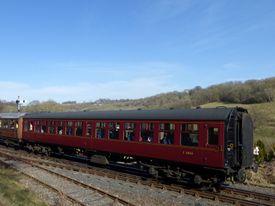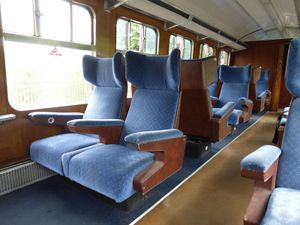| BR 3083 Experimental Open | |
|---|---|
 BR 3083 in 2015 | |
| Built By | BR Doncaster |
| Status | In use |
| Number | E3083 |
| Livery | BR Maroon |
| Other numbers | W3083 |
| History | |
| Built | 1957 |
| Diagram | 74 |
| Lot | 30372 |
| Type | FO |
| TOPS code | AD11 |
| Seats | 36 Declassified |
| 1972 | Withdrawn by BR |
| 1973 | Entered service on SVR |
Contents
Contents
Service
Prototype Open First 3083 was built at the former LNER workshops at Doncaster in 1957 to diagram 74, Lot 30372. As built it had a weight of 33 tons and was fitted with BR1 bogies. Externally, the window spacing is different from standard Mk 1.
The interior design incorporated LNER style teak matchboard linings and aluminium trim, with 36 reclining rotating seats in 2+1 arrangement and two lavatories at one end of the carriage. Although classed as a ‘Gangwayed Open’, the seating areas are separated from the centre vestibule by swing doors. Fluorescent lighting is used within the carriage.
The carriage entered service in BR’s Eastern Region in June 1957 numbered E3083. In July 1965 it was renumbered W3083 with a transfer to the Western Region. It was finally withdrawn from BR service at London's Old Oak Common in August 1972[1][2].
Preservation
3083 arrived from Old Oak Common on 12 February 1973 and was put into service immediately after arrival, still in InterCity blue & grey livery.[3] It was repainted into BR Crimson & Cream in 1974-75, initially at Hampton Loade and completed at Bridgnorth.[4]
3083 was withdrawn from service again in March 1978 to be repainted into BR Western Region brown and cream livery for use with the dining car train.[5] It returned to service in early 1979 and continued until Spring 1985 when it was withdrawn requiring attention to leaking windows and re-covering of the seats. A quick repaint into BR Maroon was envisaged,[6] but in the event an extended heavy general repair was undertaken which began in December 1985[7] and was finally completed during 1990 with the carriage re-entering service in BR Maroon livery.[8]
In 1999 3083 was reallocated for a period of use in the LNER Teak set. In summer of that year the carriage was repainted in BR Eastern Region Mock Teak using a process known as ‘scumble-graining’. This type of finish was used on LNER steel-bodied Thompson coaches towards the end of the LNER era in 1946-48.[9]
3083 received a further overhaul in mid-2009, reverting to 1957 BR Maroon livery with black ends and gutters but without the ‘roundels’ which were introduced later by BR.[10]
For current SVR use, the coach has been declassified (i.e. is now 'standard' class), and the seats have been locked so they no longer rotate. 3083 is often used to extend one of the regular carriage sets. The carriage is owned by SVR(H)[2].
See also
References
Links
| ||||||||||||||||||||||||||||||
